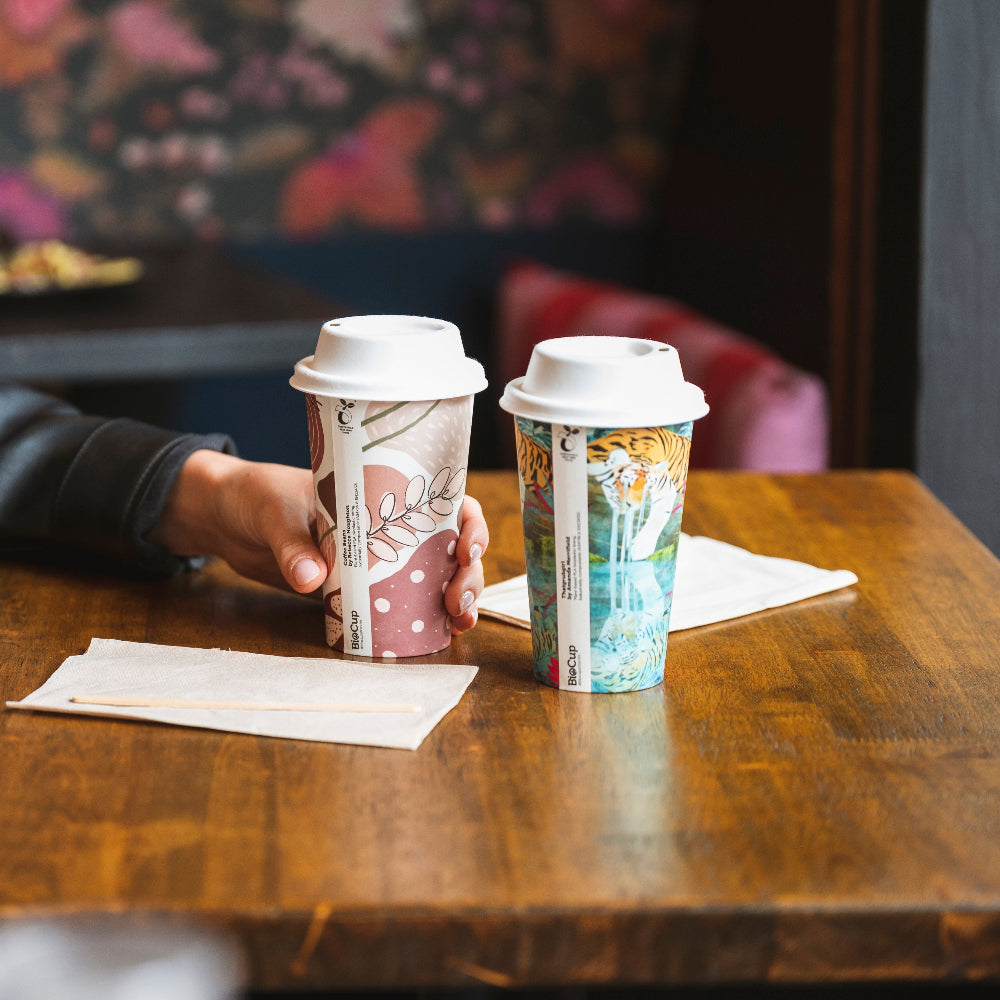
Not All Cup Linings Are Equal: What You Need to Know
Share
When it comes to takeaway cups and hot food containers, the lining is doing a lot of heavy lifting. Without it, that flat white would seep straight through your paper cup, or your curry would turn your kraft box into a soggy mess. But not all linings are created equal, and more importantly, not all are equal in terms of environmental impact.
In this blog, we’ll explore the most common linings you’ll come across – Aqueous, PLA, and PS/PE – and help you understand the pros and cons of each.
1. Aqueous Lining
What it is:
Aqueous linings are water-based coatings applied to paper or kraft packaging. Instead of forming a thick plastic film, the coating creates a thin barrier that resists moisture and oil.
Pros:
- Fully recyclable in most UK paper recycling streams
- Home compostable (breaks down naturally without industrial facilities)
- Keeps the look and feel of kraft packaging intact
- Lightweight and low impact during production
Cons:
- Still relatively new, so not all recycling plants recognise it yet
- Slightly more expensive than traditional linings
Best for: Businesses looking to reduce plastic while still needing durable, compostable packaging.
2. PLA (Polylactic Acid) Lining
What it is:
PLA is a plant-based bioplastic, usually made from corn starch or sugarcane. It’s used as a thin film lining in many compostable cups and containers.
Pros:
- Plant-based and renewable, not fossil fuel derived
- Certified compostable in industrial facilities
- Provides a strong moisture and heat barrier
- Commonly available and affordable compared to aqueous
Cons:
- Needs an industrial composting facility to break down properly (not home compostable)
- If thrown into general recycling, it contaminates the stream as it behaves differently to conventional plastics
- Limited UK infrastructure for PLA composting, meaning a lot still ends up in landfill
Best for: Businesses with access to commercial composting collections, or cafés keen to market plant-based packaging.
3. PS (Polystyrene) or PE (Polyethylene) Linings
What it is:
Traditional linings used for decades, PS and PE are petroleum-based plastics applied as a thin layer inside cups and containers. They keep drinks hot and food leak-proof.
Pros:
- Widely available and inexpensive
- Heat and moisture resistant
- Familiar, proven, and reliable
Cons:
- Not compostable or biodegradable
- Difficult to recycle as the plastic layer is bonded to the paper
- Contributes to plastic pollution and landfill waste
- Increasingly seen as outdated and unsustainable
Best for: Budget-conscious operations, though many are phasing out in favour of eco alternatives.
The Environmental Picture
If sustainability is your priority, aqueous lining is the clear winner, followed by PLA when commercial composting is available. PS/PE linings are still common, but they carry the biggest environmental burden.
The challenge is that no single lining is perfect everywhere. Aqueous works well if your local recycling can handle it. PLA works well if you can ensure industrial composting. PS/PE works if price is the only concern, but it’s not a long-term solution as regulations tighten.
FAQs
Can I put aqueous-lined cups in my paper recycling bin?
Yes, in most cases aqueous-lined cups are accepted as paper recycling, but always check with your local council.
Are PLA cups home compostable?
No. PLA needs high heat and specific conditions only found in industrial composting facilities.
Why can’t I just recycle PS or PE lined cups?
Because the plastic is fused to the paper, separating them is technically difficult and rarely done by local recycling plants.
Do aqueous linings affect the taste of food or drinks?
Not at all. Aqueous linings are flavour-neutral, so your coffee still tastes like coffee and not like packaging.
Are PLA cups safe for hot drinks?
Yes, PLA linings are heat-resistant and perform well with hot beverages, although they do better with industrial composting afterwards.
Will regulations ban PS/PE linings in the UK?
While not banned outright yet, pressure is increasing. Many businesses are already switching to aqueous or PLA to get ahead of future legislation.
Choosing the right lining for your hot food and beverage packaging isn’t just about keeping leaks at bay. It’s also about sending the right message to your customers and reducing your environmental footprint. At Reign Packaging, we believe small switches add up to big change. Whether you’re leaning towards aqueous, PLA, or still navigating away from PS/PE, we’re here to guide you through eco-friendly choices that work for your business.
👉 Explore our full range of eco-friendly takeaway packaging **REIGN PACKAGING AND SUPPLIES**
